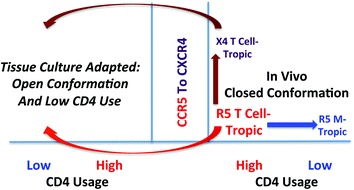Fig. 2.

Pathways for the evolution of the HIV-1 Env protein entry phenotype. The major entry phenotype form for HIV-1 is the R5 T cell-tropic form. It uses CCR5 as the coreceptor, but requires a high density of CD4, as is found on T cells, for efficient entry. In vivo it evolves to switch coreceptor to use CXCR4. Alternatively, it can evolve to use a low density of CD4 to enter cells such as macrophages, which have a density of CD4 about 25-fold lower than that found on T cells. Also in vivo, these viruses are found in a closed conformation, i.e., resistant to neutralization, especially to antibodies targeting the epitopes exposed after binding CD4. In cell culture the virus follows another evolutionary pathway in which an open conformation is generated allowing the use of a low density of CD4 for entry. Presumably this enables more rapid entry under culture conditions. This can happen for both the X4 form of the virus and the R5 T cell-tropic form of the virus and should be considered an artifact of tissue culture adaptation
